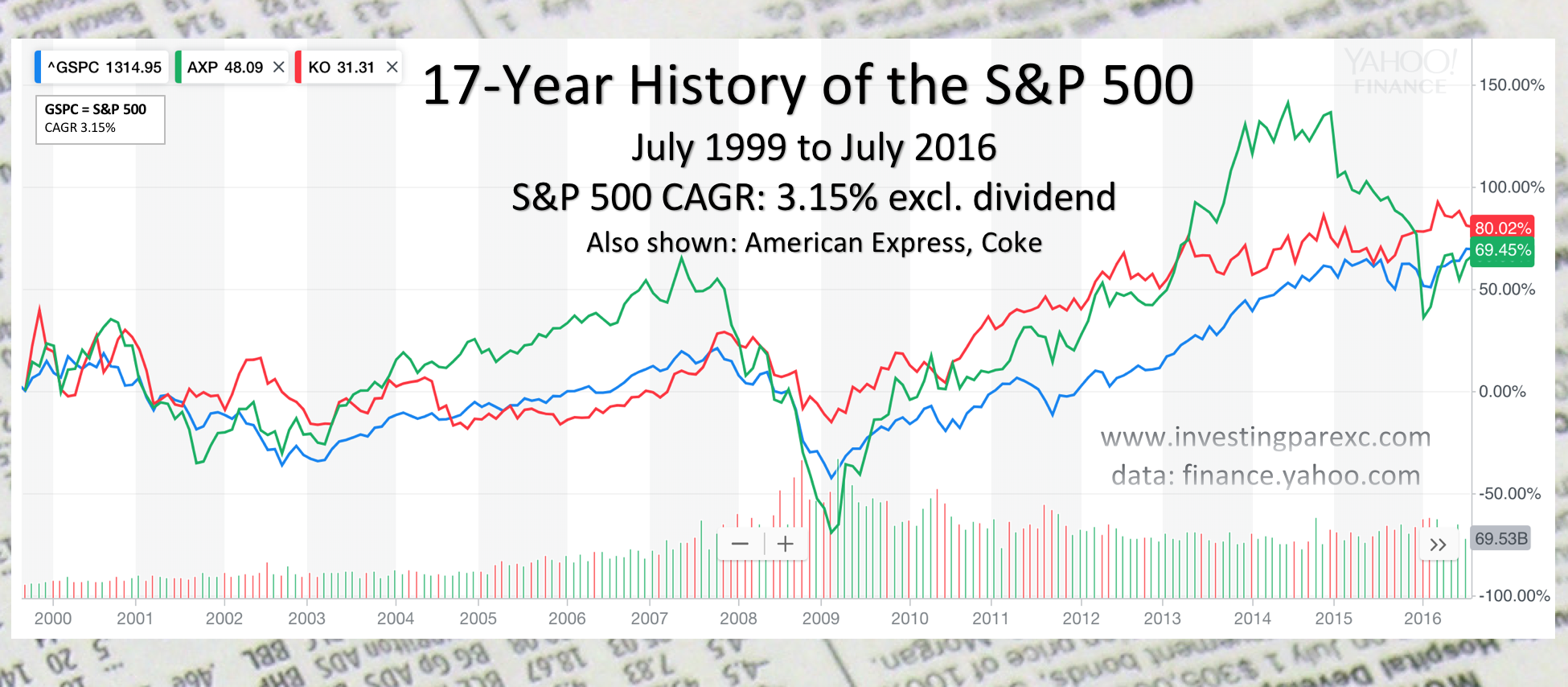 In July 1999, Warren Buffett gave a speech to business leaders in Sun Valley, Idaho. Back then, the U.S. stock market had been on a tear. Understandably, many attendees were very optimistic about their businesses’ prospects. Undaunted though, Buffett went on to make the argument that investors’ expectations were too high for the coming decade and that they were bound to be disappointed. His best guess was 6% nominal return over the next 17 years. A subpar performance at best.
In July 1999, Warren Buffett gave a speech to business leaders in Sun Valley, Idaho. Back then, the U.S. stock market had been on a tear. Understandably, many attendees were very optimistic about their businesses’ prospects. Undaunted though, Buffett went on to make the argument that investors’ expectations were too high for the coming decade and that they were bound to be disappointed. His best guess was 6% nominal return over the next 17 years. A subpar performance at best.
That day, he made a compelling case for poor future results – and yet he didn’t sell any of his long-term holdings like American Express (AXP), Coke (KO) or Wells Fargo (WFC). Why? Because, in his own words, when he finds a good business his favorite holding period is forever.
When we own portions of outstanding businesses with outstanding managements, our favorite holding period is forever.
Warren Buffett, Berkshire Hathaway Annual Letter 1988
When I find an excellent business, I buy its shares. And I don’t sell my stocks either unless I think the business has changed and may not be as durable/profitable as before. After all, if you own a popular coffee shop at a busy street corner and the business is very profitable, why would you sell? As I wrote in an earlier post, I bought some Starbucks shares at a bargain price in 2009. Today, I get double-digit dividend yield on those shares (on my original cost). Even if the market cuts its share price in half over the next couple of years, I’d still happily keep my shares. The business is still good and I fully expect them to keep paying me dividends even in the down years.
As long as a business is doing well, I like holding on to my shares. On occasions, the market may get too optimistic and share price rises too quickly. Rich valuations may not be justified by the business’ prospects. The market may be paying too much for the business. This is what had happened back then in 1999. I still don’t sell. Why? One, I am not good at timing the market (is anybody?). If I get out I may not get a chance to get back in at the same (or lower) price in future. Two, I don’t want to pay taxes on my gains. I think about the situation this way: if the stock has a big run up, those gains may have been pulled in from the future. As a result, the stock might tread water or even go down for the next few years. But I am ok to live with a few down years. A bird in hand, indeed.
 Just as Buffett had predicted that day in 1999, the ensuing 17 years were indeed below average for U.S. stocks. The S&P 500 had an annualized return of about 3% (excluding dividends). Throw in dividends and investors got roughly 5%. During the five years following his speech, American Express and Coke stocks went down by as much as 35% to 40%. Even his own company stock (BRK.A, BRK.B) was not spared from the downturn. From June 1998 to March 2000, Berkshire went down by 49%. Buffett must have anticipated it. He predicted the downturn, after all. And yet he wasn’t going to dump his stocks.
Just as Buffett had predicted that day in 1999, the ensuing 17 years were indeed below average for U.S. stocks. The S&P 500 had an annualized return of about 3% (excluding dividends). Throw in dividends and investors got roughly 5%. During the five years following his speech, American Express and Coke stocks went down by as much as 35% to 40%. Even his own company stock (BRK.A, BRK.B) was not spared from the downturn. From June 1998 to March 2000, Berkshire went down by 49%. Buffett must have anticipated it. He predicted the downturn, after all. And yet he wasn’t going to dump his stocks.
Here you might ask: what if the market goes in bear territory – staying down for multiple years. Wouldn’t you rather sell than see your shares get cut in half?
First off, can I really foresee a bear market on the horizon? I don’t think so. Even Buffett made this disclaimer on that day in 1999: “… valuing the market has nothing to do with where it’s going to go next week or next month or next year.”
We all must be prepared for bear markets since they are inevitable. What you do to prepare yourself? That depends on your level of risk tolerance, need for income from your portfolio, and the time horizon for your investments.
(1) Risk Tolerance: How tolerant are you to unrealized losses? It is something you won’t really know unless you go through at least one bear market. Suffice it to say, most people would rather avoid bear markets completely. Barring that, many would like to reduce their exposure to losses (even if they are temporary losses).
I consider myself fairly risk tolerant. I have been through two bear markets in last two decades. I also keep cash for two years’ worth of living expenses (my rainy-day fund) as a way to keep my portfolio secure from ill-timed withdrawals. I also keep dry powder to take advantage of a down market – whenever it may come.
(2) Need for income: Most individual investors are net savers. They don’t need to generate regular income from investments. They are earning income elsewhere. Still, some people feel more comfortable seeing their investments throw off some cash. But this is only psychological. If one doesn’t need to consume this cash, why focus on it. I wrote about investors’ obsession for dividends previously.
In my case, I do derive some income from my portfolio for consumption. But I do that primarily through dividends and by writing stock options. As I mentioned in a previous post, I don’t keep bonds for income.
But I leave my long-term stock holdings alone. I don’t write call options on them; nor do I sell when they go down in value. I also reinvest all dividends. I look at it this way: if I am satisfied with the income that my portfolio is generating then bear-market value drops shouldn’t matter as much. After all, I am not planning to liquidate my portfolio. What if my portfolio’s value drops for a period of time; it will recover over time.
(3) Time horizon: I only invest money that I won’t need for at least five years. For near-term needs, I keep rainy-day funds in cash as I mentioned earlier. This ensures that I won’t be forced to sell stocks while the market is down. Since 1950, the US market has never had a five-year run where it was down by more than 3%. On the other hand, it has gone up as high as 28%. Those are the low-risk high-reward odds that I am willing to take with my investments.
It’s not that I never sell a stock. I do. But those are usually my investment mistakes. I had misjudged weak businesses for durable franchises (examples include Nokia, Lumber Liquidators, Allied Irish Bank). Or I disapproved management decisions (in case of Infinera, for instance). In some cases, companies I bought were acquired — forcing me to sell my positions (for example: Precision Castparts, Whole Foods). In yet other cases, I had made good profits but no longer consider the businesses to be durable long-term kind (Oracle, Lennar, Open Text).
Event-driven investing? The focus of this article is long-term compounders — businesses that, I trust, will compound my capital multiple times over the years. These are not short-term event-driven investments that would require specific exit strategies in limited time frames. Such as mergers, spinoffs, bankruptcies, etc. Nothing wrong with investing in them. Buffett calls them “workouts” or “securities with a timetable”. I haven’t done many of those in the past but if I were to invest in “workouts”, I wouldn’t be so laissez-faire in my selling approach.
Businesses do run into rough patches every once in a while. My task then is to distinguish between a short-term hiccup and permanent deterioration of business model. For reasons discussed earlier, I don’t consider price drops to be necessarily signs of trouble. A major strategy change, a significant acquisition, or a management overhaul might raise a flag though.
Buy and forget? However, even good businesses don’t last forever. But hopefully they will outlast our investing careers. In that vein, I don’t do buy-and-forget investing. Yes, I buy for the long term, but I also closely follow those businesses to monitor my investment theses. At a minimum, I check quarterly results and listen to earnings conference calls. For the most part though I am willing to give them a long leash. Like Buffett has done with American Express and Coke.
I will leave you with these parting thoughts from Joel Greenblatt, another one of my favorite investors. He writes in his excellent easy-to-read book, The Big Secret for the Small Investor:
For those investing in individual stocks, the benefits to looking past the next quarter or the next year, to investing in companies that may take several years before they can show good results, to truly taking a long-term perspective when evaluating a stock investment remain as large, if not larger, than they have ever been.
Amen to that! I am already looking forward to the next 17 years.
Leave a Reply